北师大版(2019) 必修第三册 Unit 8 Green Living Lesson 1 Roots and Shoots Grammar课件(15张)
文档属性
| 名称 | 北师大版(2019) 必修第三册 Unit 8 Green Living Lesson 1 Roots and Shoots Grammar课件(15张) | 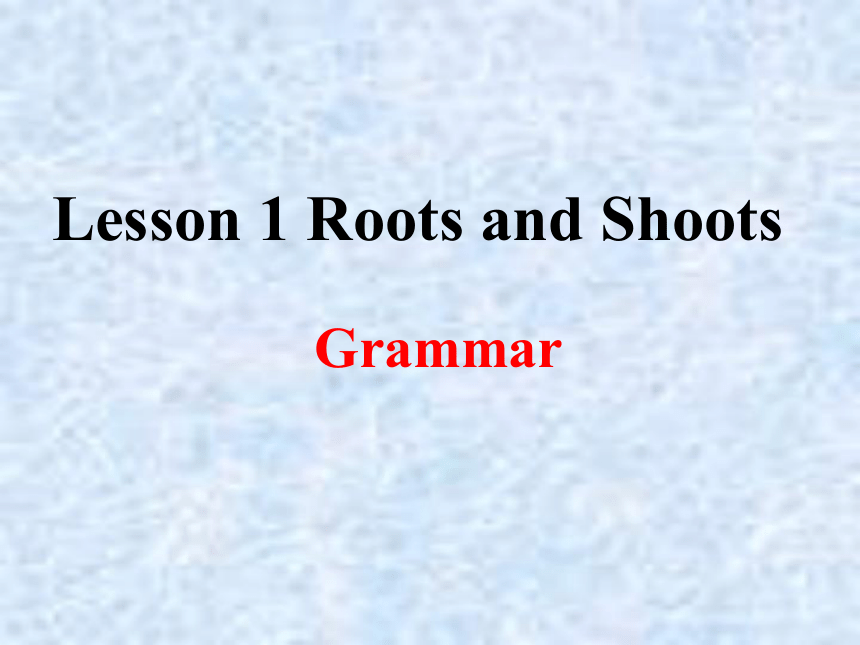 | |
| 格式 | pptx | ||
| 文件大小 | 225.6KB | ||
| 资源类型 | 教案 | ||
| 版本资源 | 北师大版(2019) | ||
| 科目 | 英语 | ||
| 更新时间 | 2022-04-01 12:42:44 | ||
图片预览

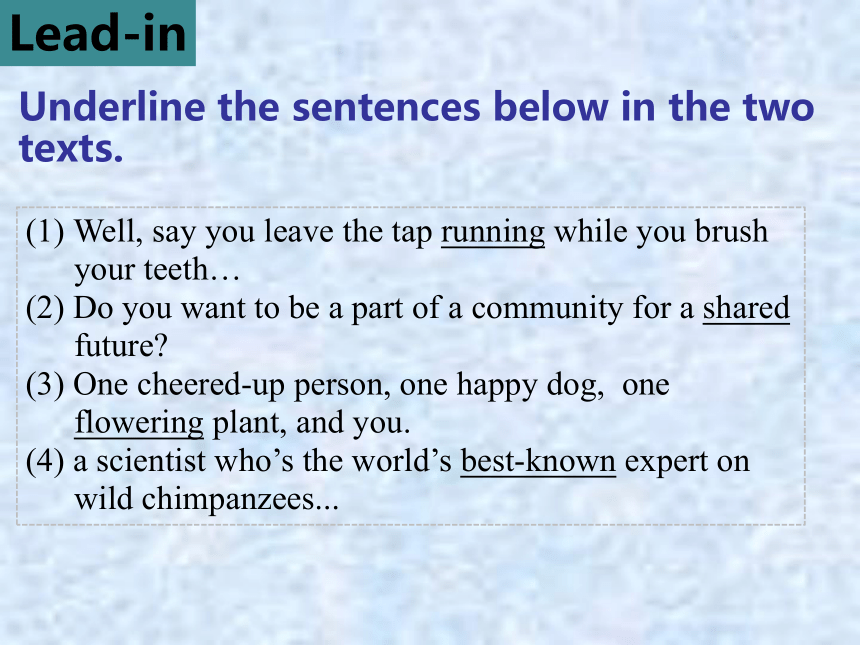
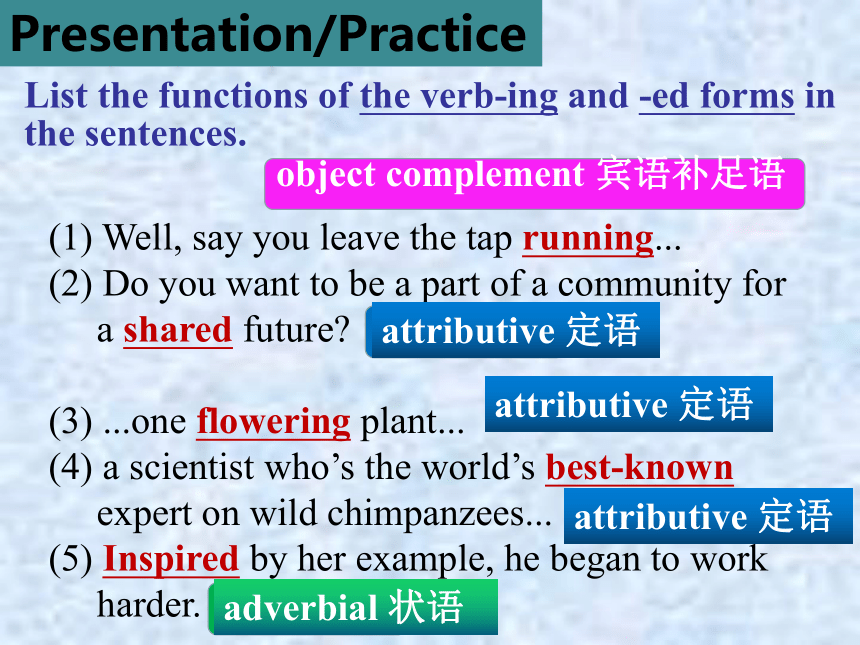

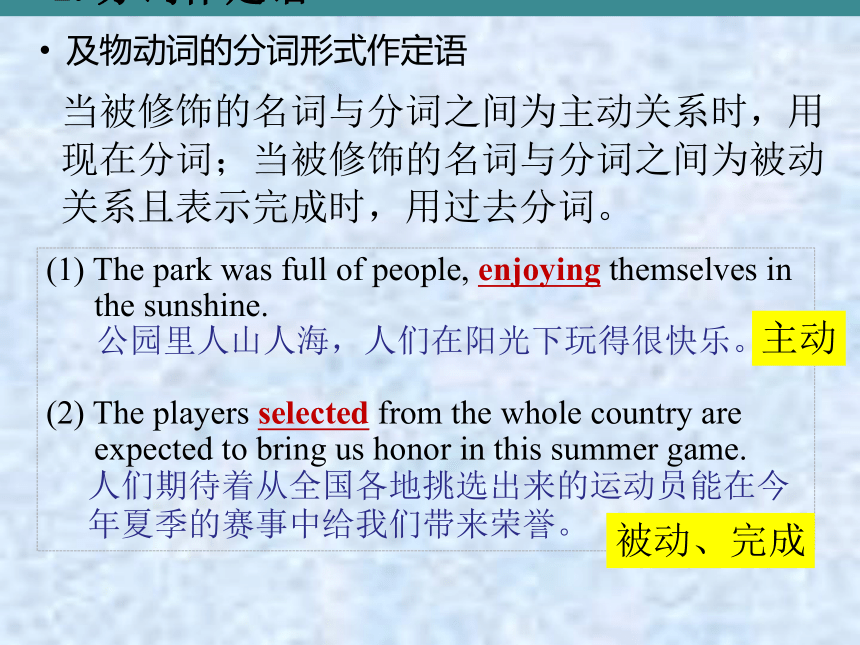
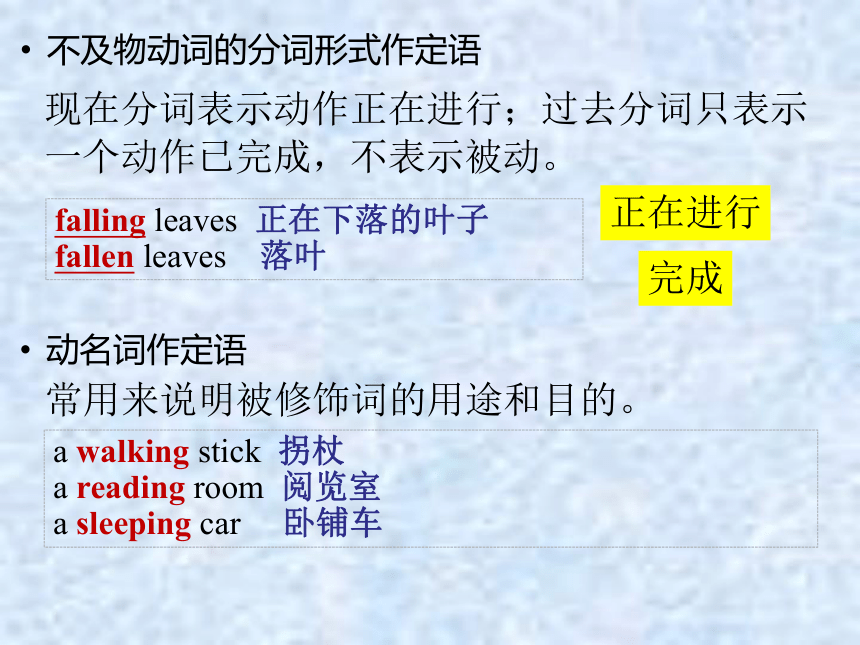

文档简介
(共15张PPT)
Lesson 1 Roots and Shoots
Grammar
Lead-in
Underline the sentences below in the two texts.
(1) Well, say you leave the tap running while you brush your teeth…
(2) Do you want to be a part of a community for a shared future
(3) One cheered-up person, one happy dog, one flowering plant, and you.
(4) a scientist who’s the world’s best-known expert on wild chimpanzees...
(1) Well, say you leave the tap running...
(2) Do you want to be a part of a community for a shared future
(3) ...one flowering plant...
(4) a scientist who’s the world’s best-known expert on wild chimpanzees...
(5) Inspired by her example, he began to work harder.
Presentation/Practice
List the functions of the verb-ing and -ed forms in the sentences.
object complement 宾语补足语
attributive 定语
adverbial 状语
attributive 定语
attributive 定语
现在分词和过去分词的用法
现在分词和过去分词是非谓语动词的形式。它在句子中可以充当定语、状语和宾语补足语、表语等。
The crying child had a cut on his knee.
Those students came into the room, singing and laughing.
As I walked past the room, I heard two people arguing.
The football game was exciting.
attributive
adverbial
object complement
predicative
The recovered animals will be released soon.
When he entered the room, he found the window broken.
Built in 1760, the house is over 200 years old.
The street is lined with small shops.
attributive
object complement
adverbial
predicative
1. 分词作定语
当被修饰的名词与分词之间为主动关系时,用
现在分词;当被修饰的名词与分词之间为被动
关系且表示完成时,用过去分词。
(1) The park was full of people, enjoying themselves in the sunshine.
公园里人山人海,人们在阳光下玩得很快乐。
(2) The players selected from the whole country are expected to bring us honor in this summer game.
人们期待着从全国各地挑选出来的运动员能在今
年夏季的赛事中给我们带来荣誉。
及物动词的分词形式作定语
主动
被动、完成
现在分词表示动作正在进行;过去分词只表示
一个动作已完成,不表示被动。
falling leaves 正在下落的叶子
fallen leaves 落叶
不及物动词的分词形式作定语
正在进行
完成
常用来说明被修饰词的用途和目的。
a walking stick 拐杖
a reading room 阅览室
a sleeping car 卧铺车
动名词作定语
2. 分词作状语
Translated into English, the sentence was found to have an entirely different word order.
被译成英语后,我们发现这个句子有了一个完全
不同的语序。
Hearing their teacher’s voice, the pupils stopped
talking at once.
一听到教师的声音,学生们立即停止讲话。
(1)作时间状语相当于when、while、before、since、as 引导的时间状语从句。
被动且动作已完成
主动且动作正在进行
Not understanding this problem, he asked the teacher
about it.
=Because he didn’t understand this problem, he asked
the teacher about it.
因为不理解这个问题,他问了老师。
Defeated by his deskmate, he felt discouraged.
= Because he was defeated by his deskmate, he felt
discouraged.
由于被同桌打败了,他感到气馁。
(2)作原因状语相当于because、since、as引导的原因状语从句。
Given another hour, I can also work out this problem.
=If I’m given another hour, I can also work out the
problem.
如果再给我一个小时,我也能解决这个问题。
(3)作条件状语相当于if、unless等引导的条件状语从句。
People from all the corners came to the city center, making it very crowd.
来自各个角落的人都来到了市中心,这使市中心
非常拥挤。
(4)作结果状语常用现在分词表示自然而然的结果,分词可接thus。
One evening Harry phoned me, asking me to come
to his flat as soon as possible.
= One evening Harry phoned me, and he asked me to
come to his flat as soon as possible.
一天晚上哈利给我打电话,要求我尽快去他的公
寓。
He stood there silently, moved to tears.
他静静地站在那里,被感动得热泪盈眶。
(5)作方式或伴随状语表示一个同时发生的次要的或伴随的动作,常用逗号与句子主体部分隔开,相当于并列句。
Warned of the danger, he still went skating on the thin ice.
=Though he was warned of the danger, he still went
skating on the thin ice.
虽然被警告危险,他仍旧在薄冰上滑冰。
Living miles away, he attended the course.
= Although he lived miles away, he attended the course.
虽然住在几英里以外,他仍去上课。
(6)让步状语相当于though、although、even if等引导的让步状语从句。
3.分词作宾语补足语
They use computers to keep the traffic running smoothly.
他们使用电脑以使交通畅通无阻。
He tried to get his work recognized in the medical circles.
他试图使自己的工作在医学界得到认可。
He had his wallet stolen on his way home.
在回家的路上,他的钱包被偷了。
He had the light burning all night, which made his parents very angry.
他让灯亮了整晚,这使他父母很生气。
现在分词作宾语补足语时,表主动、进行;
过去分词作宾语补足语时,表被动、完成。
Lesson 1 Roots and Shoots
Grammar
Lead-in
Underline the sentences below in the two texts.
(1) Well, say you leave the tap running while you brush your teeth…
(2) Do you want to be a part of a community for a shared future
(3) One cheered-up person, one happy dog, one flowering plant, and you.
(4) a scientist who’s the world’s best-known expert on wild chimpanzees...
(1) Well, say you leave the tap running...
(2) Do you want to be a part of a community for a shared future
(3) ...one flowering plant...
(4) a scientist who’s the world’s best-known expert on wild chimpanzees...
(5) Inspired by her example, he began to work harder.
Presentation/Practice
List the functions of the verb-ing and -ed forms in the sentences.
object complement 宾语补足语
attributive 定语
adverbial 状语
attributive 定语
attributive 定语
现在分词和过去分词的用法
现在分词和过去分词是非谓语动词的形式。它在句子中可以充当定语、状语和宾语补足语、表语等。
The crying child had a cut on his knee.
Those students came into the room, singing and laughing.
As I walked past the room, I heard two people arguing.
The football game was exciting.
attributive
adverbial
object complement
predicative
The recovered animals will be released soon.
When he entered the room, he found the window broken.
Built in 1760, the house is over 200 years old.
The street is lined with small shops.
attributive
object complement
adverbial
predicative
1. 分词作定语
当被修饰的名词与分词之间为主动关系时,用
现在分词;当被修饰的名词与分词之间为被动
关系且表示完成时,用过去分词。
(1) The park was full of people, enjoying themselves in the sunshine.
公园里人山人海,人们在阳光下玩得很快乐。
(2) The players selected from the whole country are expected to bring us honor in this summer game.
人们期待着从全国各地挑选出来的运动员能在今
年夏季的赛事中给我们带来荣誉。
及物动词的分词形式作定语
主动
被动、完成
现在分词表示动作正在进行;过去分词只表示
一个动作已完成,不表示被动。
falling leaves 正在下落的叶子
fallen leaves 落叶
不及物动词的分词形式作定语
正在进行
完成
常用来说明被修饰词的用途和目的。
a walking stick 拐杖
a reading room 阅览室
a sleeping car 卧铺车
动名词作定语
2. 分词作状语
Translated into English, the sentence was found to have an entirely different word order.
被译成英语后,我们发现这个句子有了一个完全
不同的语序。
Hearing their teacher’s voice, the pupils stopped
talking at once.
一听到教师的声音,学生们立即停止讲话。
(1)作时间状语相当于when、while、before、since、as 引导的时间状语从句。
被动且动作已完成
主动且动作正在进行
Not understanding this problem, he asked the teacher
about it.
=Because he didn’t understand this problem, he asked
the teacher about it.
因为不理解这个问题,他问了老师。
Defeated by his deskmate, he felt discouraged.
= Because he was defeated by his deskmate, he felt
discouraged.
由于被同桌打败了,他感到气馁。
(2)作原因状语相当于because、since、as引导的原因状语从句。
Given another hour, I can also work out this problem.
=If I’m given another hour, I can also work out the
problem.
如果再给我一个小时,我也能解决这个问题。
(3)作条件状语相当于if、unless等引导的条件状语从句。
People from all the corners came to the city center, making it very crowd.
来自各个角落的人都来到了市中心,这使市中心
非常拥挤。
(4)作结果状语常用现在分词表示自然而然的结果,分词可接thus。
One evening Harry phoned me, asking me to come
to his flat as soon as possible.
= One evening Harry phoned me, and he asked me to
come to his flat as soon as possible.
一天晚上哈利给我打电话,要求我尽快去他的公
寓。
He stood there silently, moved to tears.
他静静地站在那里,被感动得热泪盈眶。
(5)作方式或伴随状语表示一个同时发生的次要的或伴随的动作,常用逗号与句子主体部分隔开,相当于并列句。
Warned of the danger, he still went skating on the thin ice.
=Though he was warned of the danger, he still went
skating on the thin ice.
虽然被警告危险,他仍旧在薄冰上滑冰。
Living miles away, he attended the course.
= Although he lived miles away, he attended the course.
虽然住在几英里以外,他仍去上课。
(6)让步状语相当于though、although、even if等引导的让步状语从句。
3.分词作宾语补足语
They use computers to keep the traffic running smoothly.
他们使用电脑以使交通畅通无阻。
He tried to get his work recognized in the medical circles.
他试图使自己的工作在医学界得到认可。
He had his wallet stolen on his way home.
在回家的路上,他的钱包被偷了。
He had the light burning all night, which made his parents very angry.
他让灯亮了整晚,这使他父母很生气。
现在分词作宾语补足语时,表主动、进行;
过去分词作宾语补足语时,表被动、完成。
同课章节目录
- Unit 7 Art
- Lesson 1 Masterpieces
- Lesson 2 Beijing Opera
- Lesson 3 A Musical Genius
- Unit 8 Green living
- Lesson 1 Roots and Shoots
- Lesson 2 Greening the Desert
- Lesson 3 "White Bikes" on the Road
- Unit 9 Learning
- Lesson 1 Active Learning
- Lesson 2 Language Learning Tips
- Lesson 3 The Secrets of Your Memory
